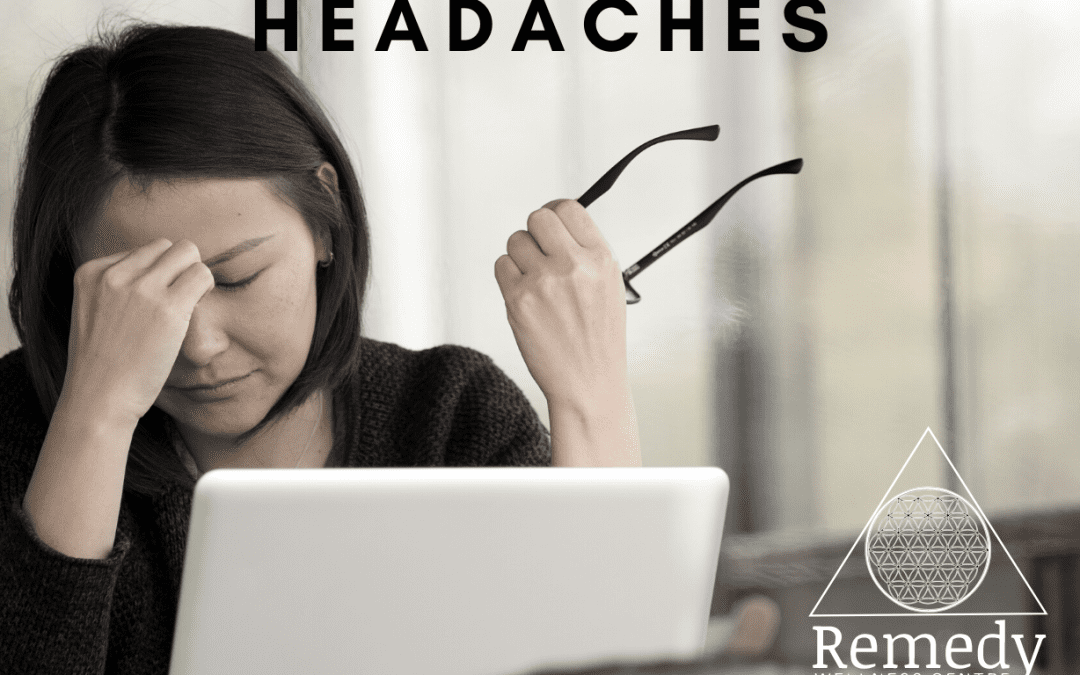Headaches can be awful, especially when they happen often. Its normal to have to occasional headache that you can explain like a dehydration headache, or a hangover headache. The often clear up on their own or by rehydrating. But what if they happen often and don’t go away easily? Then it’s time to investigate further and figure out what kind of headache you’re experiencing, as this will change the treatment approach.
There are four main types of headaches:
1. Tension Headaches (also known as muscle contraction headaches): Tension headaches are by far the most common type of headache. They are believed to be caused by referral pain from trigger points in the muscles of the neck, shoulders and jaw. Tension headaches can be brought on by stress, poor posture, misalignment of the neck or over exertion with exercise. Tension headaches often start gradually and are characterized by mild, steady or dull aching with a pressing/ squeezing, non-pulsating quality. The pressure can be located on both sides of the head, or can feel like a band around the head or the back of the neck. It can also be point specific or feel like you have “brain fog.” The area you experience the headache is an indicator of where you may have trigger points and muscle tension. Please see the diagram below for examples.
If you are experiencing tension headaches, we would recommend starting with massage therapy, physiotherapy or chiropractic. We work with tension headache symptoms every day.
2. Migraine Headaches: Migraines are not yet fully understood, but seem to be caused by changes in the chemicals of the brain that control the narrowing and dilating of blood vessels of the brain. Low levels of serotonin (a brain chemical) may also play a role blood vessels tone. Migraine headaches are characterized by severe throbbing, increased sensitivity to light and sound, nausea, vertigo and vomiting and may also be accompanied by ringing in the ears, motor coordination disturbance, double vision or partial blindness, weakness, numbness or tingly sensations. Migraines usually affect one half of the head more than the other. The cause of migraine headaches is not fully understood but some triggers include perfumes/colognes, food sensitivities, loud noises and stress.
If you are experiencing migraines, we recommend you see our Naturopathic Physician or Acupuncturist. Both are great places to start to try to figure out what is triggering your migraines. We would also recommend you consult with your family doctor. If you don’t have a family doctor, our Naturopathic Doctor can fill that role.
3. Cluster Headaches (also known as suicide headaches): Cluster headaches are intermittent in nature, but are extremely intense and painful. They typically start around one eye or one temple then quickly spread to surrounding areas on that side of the head. Their cause is unknown. The pain is mostly located around the facial area and is described as being like stabbing, electric shocks, burning, pressing, crushing, exploding or shooting pain that becomes intractable.
If you are experiencing migraines, we recommend you see our Naturopathic Physician or Acupuncturist. Both are great places to start to try to figure out what is triggering your cluster headaches.
4. Dehydration Headaches: Dehydration is one of the most common causes of headaches, therefore rehydration is the appropriate treatment method. Dehydration headaches can also be caused by consuming too much caffeine, which is a natural diuretic.
Common Headache Triggers
- Food Allergies (Allergic Reaction) & Food Sensitivities (Inflammatory Reaction)
- Blood Sugar Imbalances
- Dehydration & Mineral Imbalance
- Lack of Sleep
- Many medications have headaches listed as a side effect
- Hormone Imbalances or Fluctuations
- Exposure to Toxins and Chemicals (cigarette smoke, strong perfumes, carbon monoxide, lead, arsenic, cyanide, nitrates, insecticide)
- Alcohol
- High caffeine intake or caffeine withdrawal
- Exposure to strong light (direct sunlight without sunglasses, fluorescent lights) or flickering lights of TV and computer screens
- Poor Posture and Ergonomics
- Stress
- Muscle Tension and Trigger Points
Check Out This Video: Kira MacFayden RMT on Treatment of Headaches with Massage Therapy

